Strategic Asset Management Plan for Deepwater Horizon Disaster
VerifiedAdded on 2022/11/11
|17
|4118
|467
Report
AI Summary
This report provides a comprehensive analysis of asset management, using the Deepwater Horizon disaster as a case study. It examines the strategic asset management failures that contributed to the disaster, including inadequate risk management, poor maintenance practices, and insufficient contingency planning. The report highlights the importance of effective asset management throughout the entire asset life cycle, from acquisition and operation to maintenance and disposal. It presents a detailed risk management plan, including a risk register and mitigation strategies, along with an operating plan and equipment maintenance plans. The study underscores the financial and reputational consequences of poor asset management, emphasizing the need for robust strategies to prevent future disasters and improve operational efficiency. The report concludes with a strategic asset management plan tailored for BP, aiming to enhance its operational effectiveness and minimize the impact of potential risks.
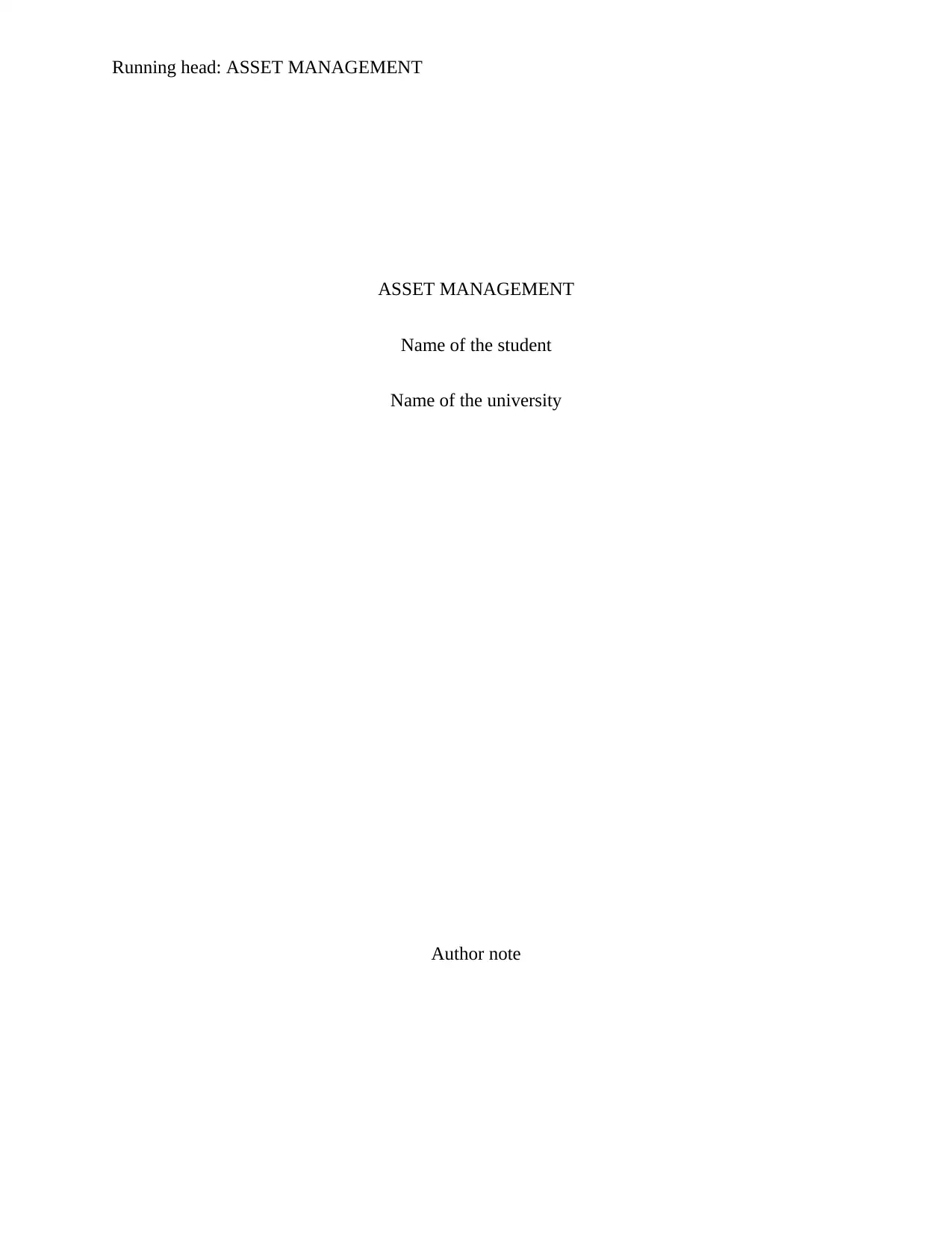
Running head: ASSET MANAGEMENT
ASSET MANAGEMENT
Name of the student
Name of the university
Author note
ASSET MANAGEMENT
Name of the student
Name of the university
Author note
Paraphrase This Document
Need a fresh take? Get an instant paraphrase of this document with our AI Paraphraser
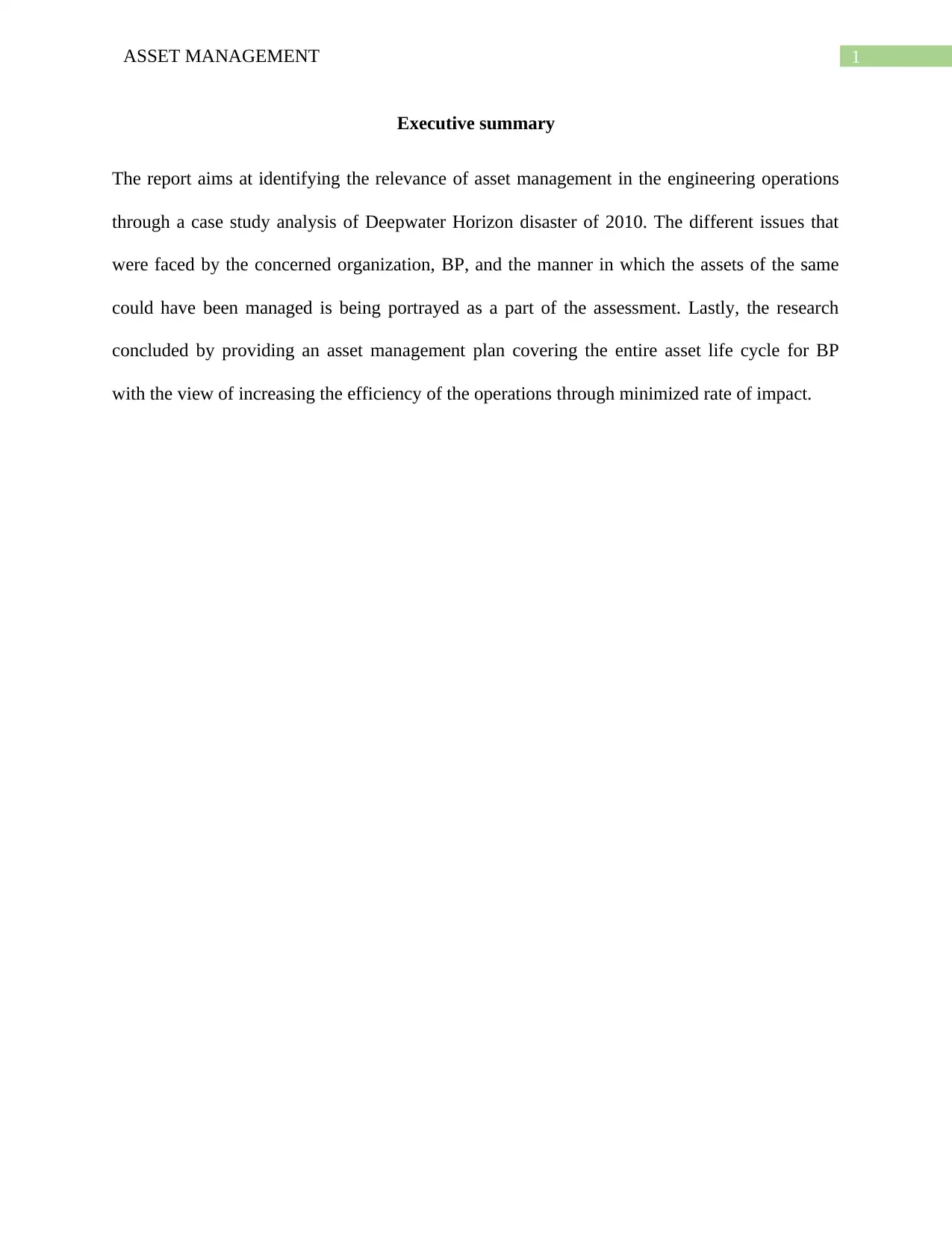
1ASSET MANAGEMENT
Executive summary
The report aims at identifying the relevance of asset management in the engineering operations
through a case study analysis of Deepwater Horizon disaster of 2010. The different issues that
were faced by the concerned organization, BP, and the manner in which the assets of the same
could have been managed is being portrayed as a part of the assessment. Lastly, the research
concluded by providing an asset management plan covering the entire asset life cycle for BP
with the view of increasing the efficiency of the operations through minimized rate of impact.
Executive summary
The report aims at identifying the relevance of asset management in the engineering operations
through a case study analysis of Deepwater Horizon disaster of 2010. The different issues that
were faced by the concerned organization, BP, and the manner in which the assets of the same
could have been managed is being portrayed as a part of the assessment. Lastly, the research
concluded by providing an asset management plan covering the entire asset life cycle for BP
with the view of increasing the efficiency of the operations through minimized rate of impact.
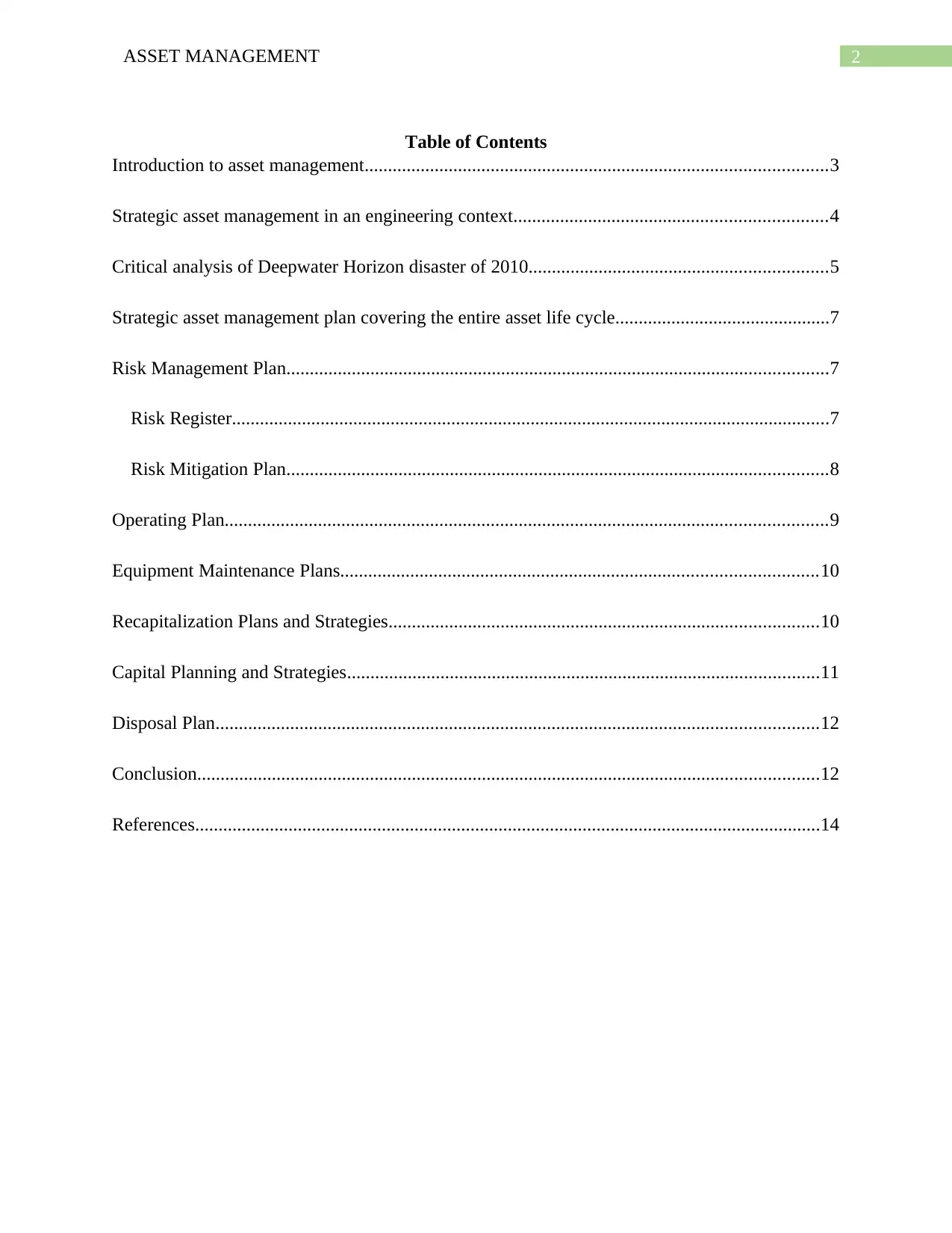
2ASSET MANAGEMENT
Table of Contents
Introduction to asset management...................................................................................................3
Strategic asset management in an engineering context...................................................................4
Critical analysis of Deepwater Horizon disaster of 2010................................................................5
Strategic asset management plan covering the entire asset life cycle..............................................7
Risk Management Plan....................................................................................................................7
Risk Register................................................................................................................................7
Risk Mitigation Plan....................................................................................................................8
Operating Plan.................................................................................................................................9
Equipment Maintenance Plans......................................................................................................10
Recapitalization Plans and Strategies............................................................................................10
Capital Planning and Strategies.....................................................................................................11
Disposal Plan.................................................................................................................................12
Conclusion.....................................................................................................................................12
References......................................................................................................................................14
Table of Contents
Introduction to asset management...................................................................................................3
Strategic asset management in an engineering context...................................................................4
Critical analysis of Deepwater Horizon disaster of 2010................................................................5
Strategic asset management plan covering the entire asset life cycle..............................................7
Risk Management Plan....................................................................................................................7
Risk Register................................................................................................................................7
Risk Mitigation Plan....................................................................................................................8
Operating Plan.................................................................................................................................9
Equipment Maintenance Plans......................................................................................................10
Recapitalization Plans and Strategies............................................................................................10
Capital Planning and Strategies.....................................................................................................11
Disposal Plan.................................................................................................................................12
Conclusion.....................................................................................................................................12
References......................................................................................................................................14
⊘ This is a preview!⊘
Do you want full access?
Subscribe today to unlock all pages.

Trusted by 1+ million students worldwide
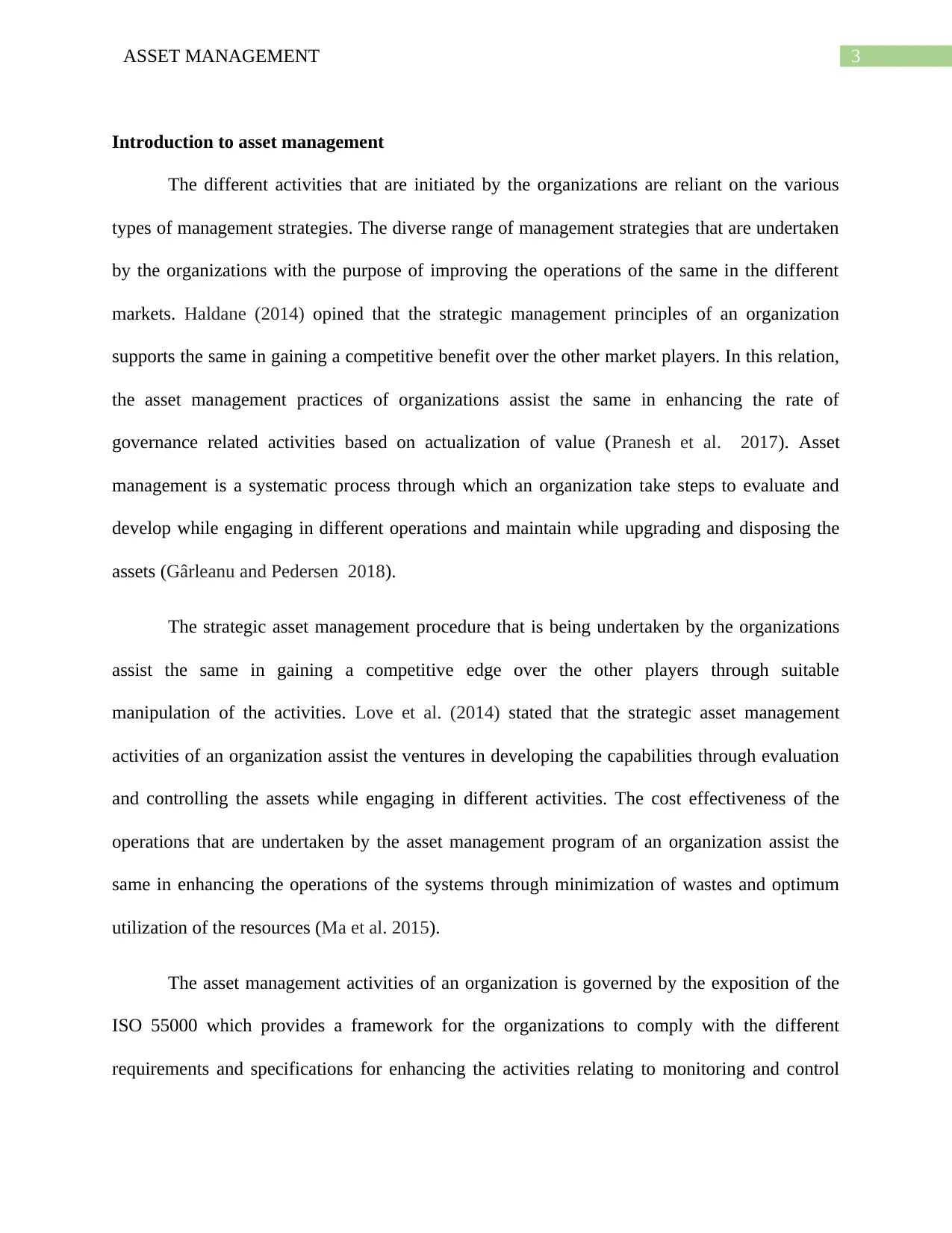
3ASSET MANAGEMENT
Introduction to asset management
The different activities that are initiated by the organizations are reliant on the various
types of management strategies. The diverse range of management strategies that are undertaken
by the organizations with the purpose of improving the operations of the same in the different
markets. Haldane (2014) opined that the strategic management principles of an organization
supports the same in gaining a competitive benefit over the other market players. In this relation,
the asset management practices of organizations assist the same in enhancing the rate of
governance related activities based on actualization of value (Pranesh et al. 2017). Asset
management is a systematic process through which an organization take steps to evaluate and
develop while engaging in different operations and maintain while upgrading and disposing the
assets (Gârleanu and Pedersen 2018).
The strategic asset management procedure that is being undertaken by the organizations
assist the same in gaining a competitive edge over the other players through suitable
manipulation of the activities. Love et al. (2014) stated that the strategic asset management
activities of an organization assist the ventures in developing the capabilities through evaluation
and controlling the assets while engaging in different activities. The cost effectiveness of the
operations that are undertaken by the asset management program of an organization assist the
same in enhancing the operations of the systems through minimization of wastes and optimum
utilization of the resources (Ma et al. 2015).
The asset management activities of an organization is governed by the exposition of the
ISO 55000 which provides a framework for the organizations to comply with the different
requirements and specifications for enhancing the activities relating to monitoring and control
Introduction to asset management
The different activities that are initiated by the organizations are reliant on the various
types of management strategies. The diverse range of management strategies that are undertaken
by the organizations with the purpose of improving the operations of the same in the different
markets. Haldane (2014) opined that the strategic management principles of an organization
supports the same in gaining a competitive benefit over the other market players. In this relation,
the asset management practices of organizations assist the same in enhancing the rate of
governance related activities based on actualization of value (Pranesh et al. 2017). Asset
management is a systematic process through which an organization take steps to evaluate and
develop while engaging in different operations and maintain while upgrading and disposing the
assets (Gârleanu and Pedersen 2018).
The strategic asset management procedure that is being undertaken by the organizations
assist the same in gaining a competitive edge over the other players through suitable
manipulation of the activities. Love et al. (2014) stated that the strategic asset management
activities of an organization assist the ventures in developing the capabilities through evaluation
and controlling the assets while engaging in different activities. The cost effectiveness of the
operations that are undertaken by the asset management program of an organization assist the
same in enhancing the operations of the systems through minimization of wastes and optimum
utilization of the resources (Ma et al. 2015).
The asset management activities of an organization is governed by the exposition of the
ISO 55000 which provides a framework for the organizations to comply with the different
requirements and specifications for enhancing the activities relating to monitoring and control
Paraphrase This Document
Need a fresh take? Get an instant paraphrase of this document with our AI Paraphraser

4ASSET MANAGEMENT
the feasible assets (Komljenovic et al. 2016). Basak and Makarov (2014) stated that the
implementation of strategic asset management principles assist an organization in developing the
operations of the same while reducing the risks and costs while operating in adherence to the
objectives of the venture. Therefore, asset management is an important concept that is being
utilized by the organizations with the view of managing the different assets in an organizational
operation.
Strategic asset management in an engineering context
The traditional asset management traditions clearly exhibited the concepts relating to the
development and control of the financial assets of an organization (Seegar et al. 2015). However,
the growing trend of engineering assets has gained a strategic and sensitive role to play in the
performance of the organizations. The development of the concepts of tangible asset
management has assisted the businesses in enhancing the process flow in the different
production, manufacturing and other supports systems. Suprayitno and Soemitro (2018) opined
that the emerging concept of Engineering Asset Management solely relied on the needs of
organizations to manage their assets while operating in diverse circumstances. The
multidisciplinary activities relating to asset management of an organization assist the same in
enhancing the potentials of an engineering based organization (Law, Smarsly and Wang 2014).
The realization of the asset management practices in the engineering based organizations
assisted the dame in developing the processes which critically aimed at optimizing the asset
structure, monitoring and control mechanisms. The engineering processes has assisted the
ventures in developing the operations related to tangible asset management which has boosted
the potentials of the organizations. Woodhouse (2014) opined that the baseline calculation of an
asset and the risks that are associated with the same assists an organization in upgrading and
the feasible assets (Komljenovic et al. 2016). Basak and Makarov (2014) stated that the
implementation of strategic asset management principles assist an organization in developing the
operations of the same while reducing the risks and costs while operating in adherence to the
objectives of the venture. Therefore, asset management is an important concept that is being
utilized by the organizations with the view of managing the different assets in an organizational
operation.
Strategic asset management in an engineering context
The traditional asset management traditions clearly exhibited the concepts relating to the
development and control of the financial assets of an organization (Seegar et al. 2015). However,
the growing trend of engineering assets has gained a strategic and sensitive role to play in the
performance of the organizations. The development of the concepts of tangible asset
management has assisted the businesses in enhancing the process flow in the different
production, manufacturing and other supports systems. Suprayitno and Soemitro (2018) opined
that the emerging concept of Engineering Asset Management solely relied on the needs of
organizations to manage their assets while operating in diverse circumstances. The
multidisciplinary activities relating to asset management of an organization assist the same in
enhancing the potentials of an engineering based organization (Law, Smarsly and Wang 2014).
The realization of the asset management practices in the engineering based organizations
assisted the dame in developing the processes which critically aimed at optimizing the asset
structure, monitoring and control mechanisms. The engineering processes has assisted the
ventures in developing the operations related to tangible asset management which has boosted
the potentials of the organizations. Woodhouse (2014) opined that the baseline calculation of an
asset and the risks that are associated with the same assists an organization in upgrading and
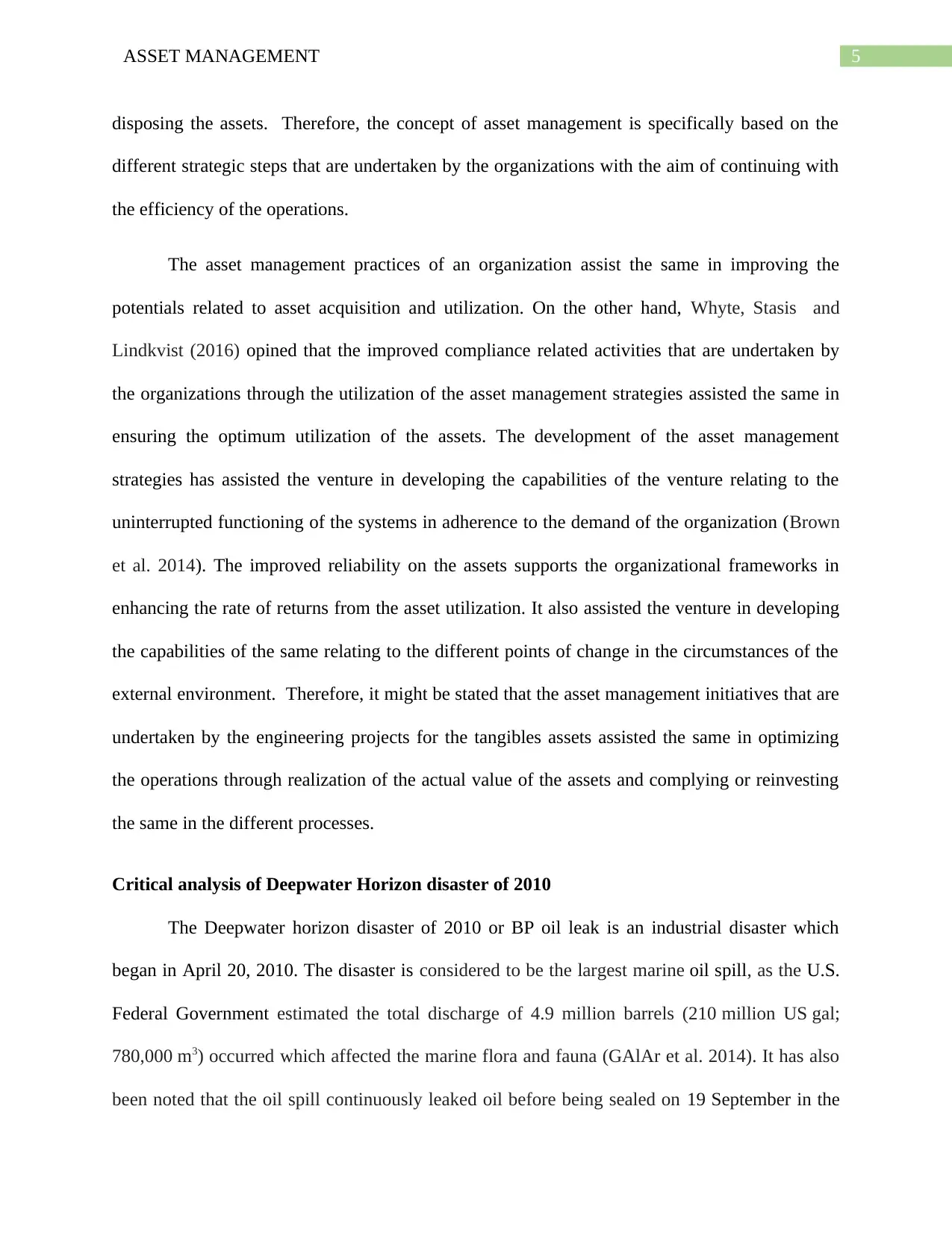
5ASSET MANAGEMENT
disposing the assets. Therefore, the concept of asset management is specifically based on the
different strategic steps that are undertaken by the organizations with the aim of continuing with
the efficiency of the operations.
The asset management practices of an organization assist the same in improving the
potentials related to asset acquisition and utilization. On the other hand, Whyte, Stasis and
Lindkvist (2016) opined that the improved compliance related activities that are undertaken by
the organizations through the utilization of the asset management strategies assisted the same in
ensuring the optimum utilization of the assets. The development of the asset management
strategies has assisted the venture in developing the capabilities of the venture relating to the
uninterrupted functioning of the systems in adherence to the demand of the organization (Brown
et al. 2014). The improved reliability on the assets supports the organizational frameworks in
enhancing the rate of returns from the asset utilization. It also assisted the venture in developing
the capabilities of the same relating to the different points of change in the circumstances of the
external environment. Therefore, it might be stated that the asset management initiatives that are
undertaken by the engineering projects for the tangibles assets assisted the same in optimizing
the operations through realization of the actual value of the assets and complying or reinvesting
the same in the different processes.
Critical analysis of Deepwater Horizon disaster of 2010
The Deepwater horizon disaster of 2010 or BP oil leak is an industrial disaster which
began in April 20, 2010. The disaster is considered to be the largest marine oil spill, as the U.S.
Federal Government estimated the total discharge of 4.9 million barrels (210 million US gal;
780,000 m3) occurred which affected the marine flora and fauna (GAlAr et al. 2014). It has also
been noted that the oil spill continuously leaked oil before being sealed on 19 September in the
disposing the assets. Therefore, the concept of asset management is specifically based on the
different strategic steps that are undertaken by the organizations with the aim of continuing with
the efficiency of the operations.
The asset management practices of an organization assist the same in improving the
potentials related to asset acquisition and utilization. On the other hand, Whyte, Stasis and
Lindkvist (2016) opined that the improved compliance related activities that are undertaken by
the organizations through the utilization of the asset management strategies assisted the same in
ensuring the optimum utilization of the assets. The development of the asset management
strategies has assisted the venture in developing the capabilities of the venture relating to the
uninterrupted functioning of the systems in adherence to the demand of the organization (Brown
et al. 2014). The improved reliability on the assets supports the organizational frameworks in
enhancing the rate of returns from the asset utilization. It also assisted the venture in developing
the capabilities of the same relating to the different points of change in the circumstances of the
external environment. Therefore, it might be stated that the asset management initiatives that are
undertaken by the engineering projects for the tangibles assets assisted the same in optimizing
the operations through realization of the actual value of the assets and complying or reinvesting
the same in the different processes.
Critical analysis of Deepwater Horizon disaster of 2010
The Deepwater horizon disaster of 2010 or BP oil leak is an industrial disaster which
began in April 20, 2010. The disaster is considered to be the largest marine oil spill, as the U.S.
Federal Government estimated the total discharge of 4.9 million barrels (210 million US gal;
780,000 m3) occurred which affected the marine flora and fauna (GAlAr et al. 2014). It has also
been noted that the oil spill continuously leaked oil before being sealed on 19 September in the
⊘ This is a preview!⊘
Do you want full access?
Subscribe today to unlock all pages.

Trusted by 1+ million students worldwide
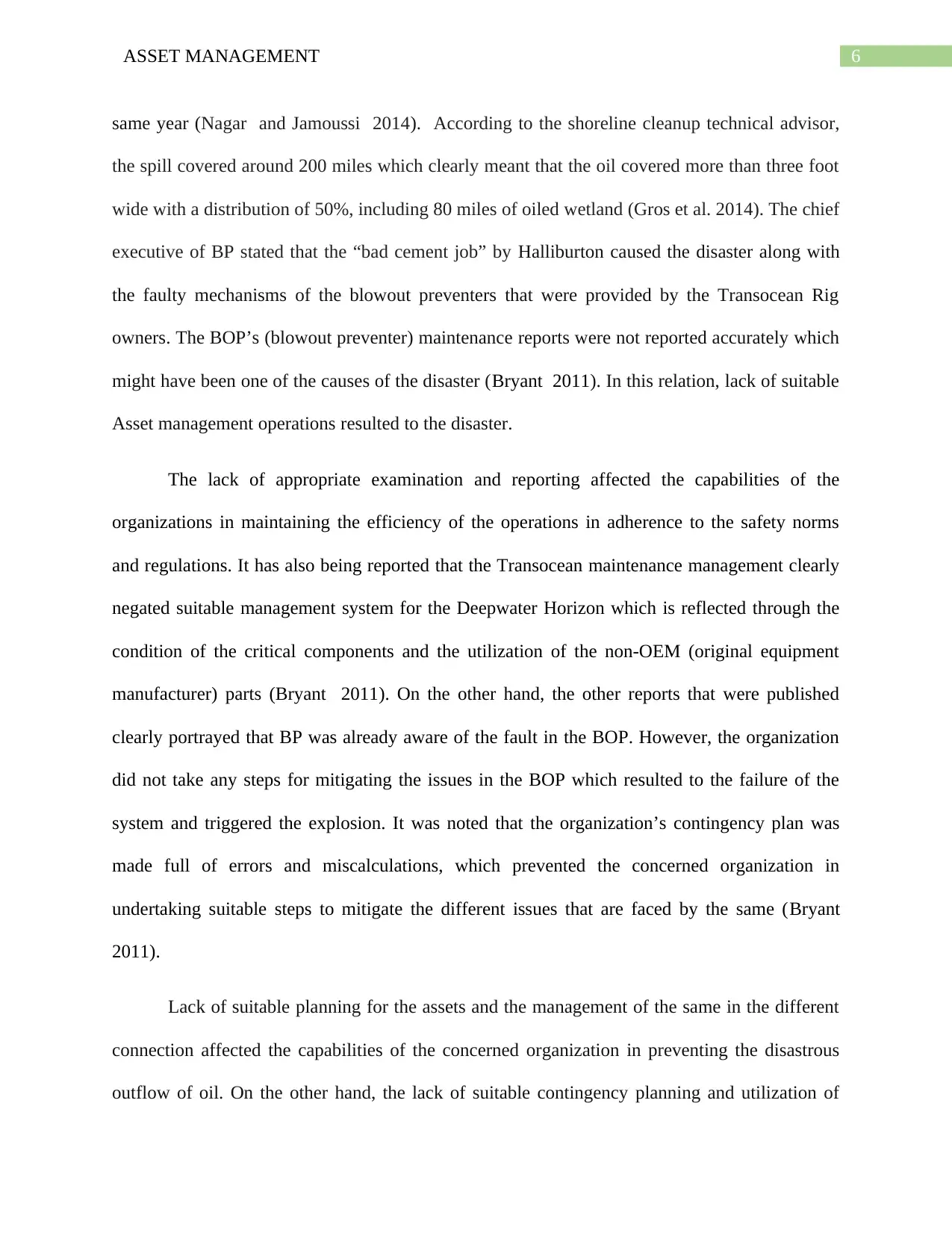
6ASSET MANAGEMENT
same year (Nagar and Jamoussi 2014). According to the shoreline cleanup technical advisor,
the spill covered around 200 miles which clearly meant that the oil covered more than three foot
wide with a distribution of 50%, including 80 miles of oiled wetland (Gros et al. 2014). The chief
executive of BP stated that the “bad cement job” by Halliburton caused the disaster along with
the faulty mechanisms of the blowout preventers that were provided by the Transocean Rig
owners. The BOP’s (blowout preventer) maintenance reports were not reported accurately which
might have been one of the causes of the disaster (Bryant 2011). In this relation, lack of suitable
Asset management operations resulted to the disaster.
The lack of appropriate examination and reporting affected the capabilities of the
organizations in maintaining the efficiency of the operations in adherence to the safety norms
and regulations. It has also being reported that the Transocean maintenance management clearly
negated suitable management system for the Deepwater Horizon which is reflected through the
condition of the critical components and the utilization of the non-OEM (original equipment
manufacturer) parts (Bryant 2011). On the other hand, the other reports that were published
clearly portrayed that BP was already aware of the fault in the BOP. However, the organization
did not take any steps for mitigating the issues in the BOP which resulted to the failure of the
system and triggered the explosion. It was noted that the organization’s contingency plan was
made full of errors and miscalculations, which prevented the concerned organization in
undertaking suitable steps to mitigate the different issues that are faced by the same (Bryant
2011).
Lack of suitable planning for the assets and the management of the same in the different
connection affected the capabilities of the concerned organization in preventing the disastrous
outflow of oil. On the other hand, the lack of suitable contingency planning and utilization of
same year (Nagar and Jamoussi 2014). According to the shoreline cleanup technical advisor,
the spill covered around 200 miles which clearly meant that the oil covered more than three foot
wide with a distribution of 50%, including 80 miles of oiled wetland (Gros et al. 2014). The chief
executive of BP stated that the “bad cement job” by Halliburton caused the disaster along with
the faulty mechanisms of the blowout preventers that were provided by the Transocean Rig
owners. The BOP’s (blowout preventer) maintenance reports were not reported accurately which
might have been one of the causes of the disaster (Bryant 2011). In this relation, lack of suitable
Asset management operations resulted to the disaster.
The lack of appropriate examination and reporting affected the capabilities of the
organizations in maintaining the efficiency of the operations in adherence to the safety norms
and regulations. It has also being reported that the Transocean maintenance management clearly
negated suitable management system for the Deepwater Horizon which is reflected through the
condition of the critical components and the utilization of the non-OEM (original equipment
manufacturer) parts (Bryant 2011). On the other hand, the other reports that were published
clearly portrayed that BP was already aware of the fault in the BOP. However, the organization
did not take any steps for mitigating the issues in the BOP which resulted to the failure of the
system and triggered the explosion. It was noted that the organization’s contingency plan was
made full of errors and miscalculations, which prevented the concerned organization in
undertaking suitable steps to mitigate the different issues that are faced by the same (Bryant
2011).
Lack of suitable planning for the assets and the management of the same in the different
connection affected the capabilities of the concerned organization in preventing the disastrous
outflow of oil. On the other hand, the lack of suitable contingency planning and utilization of
Paraphrase This Document
Need a fresh take? Get an instant paraphrase of this document with our AI Paraphraser
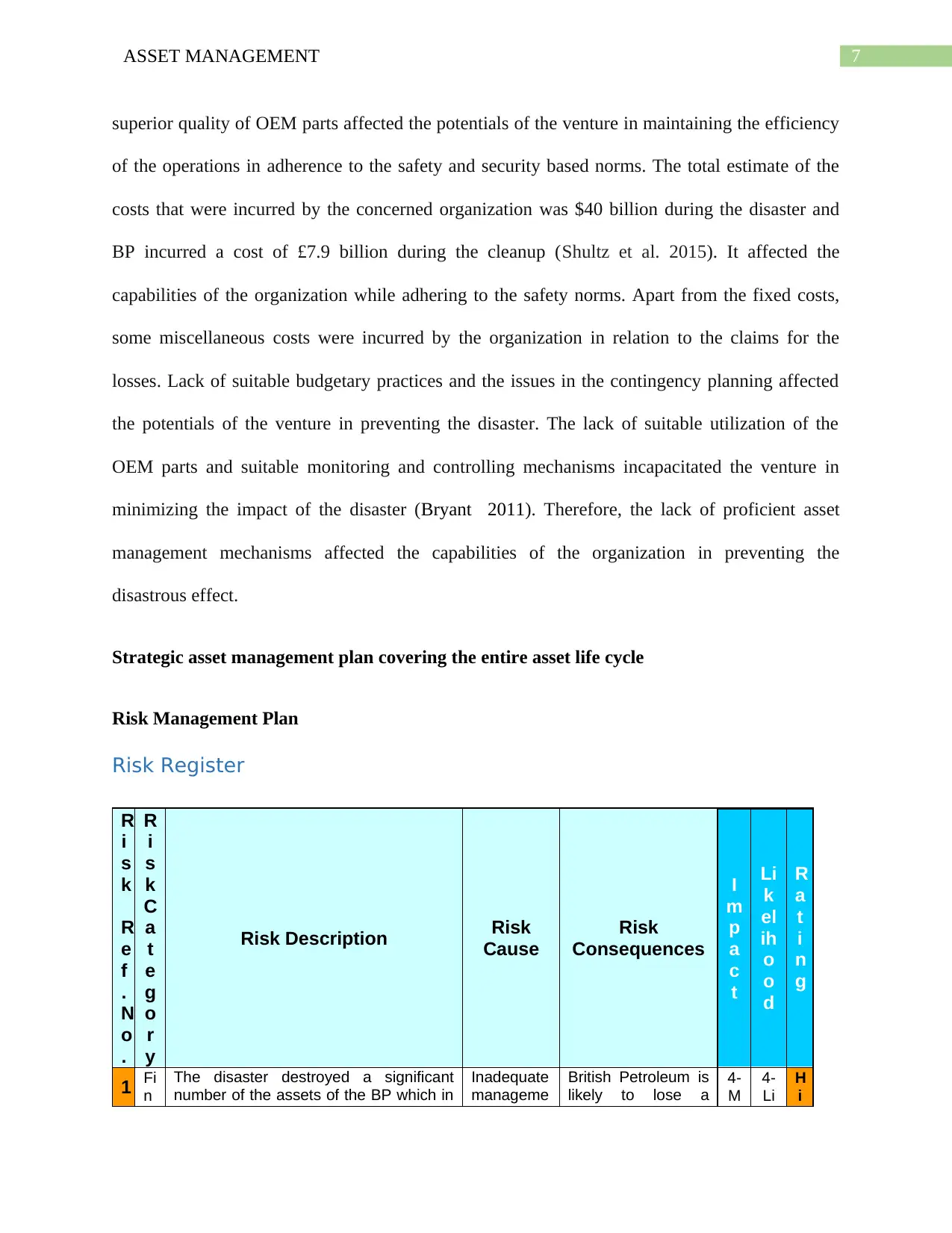
7ASSET MANAGEMENT
superior quality of OEM parts affected the potentials of the venture in maintaining the efficiency
of the operations in adherence to the safety and security based norms. The total estimate of the
costs that were incurred by the concerned organization was $40 billion during the disaster and
BP incurred a cost of £7.9 billion during the cleanup (Shultz et al. 2015). It affected the
capabilities of the organization while adhering to the safety norms. Apart from the fixed costs,
some miscellaneous costs were incurred by the organization in relation to the claims for the
losses. Lack of suitable budgetary practices and the issues in the contingency planning affected
the potentials of the venture in preventing the disaster. The lack of suitable utilization of the
OEM parts and suitable monitoring and controlling mechanisms incapacitated the venture in
minimizing the impact of the disaster (Bryant 2011). Therefore, the lack of proficient asset
management mechanisms affected the capabilities of the organization in preventing the
disastrous effect.
Strategic asset management plan covering the entire asset life cycle
Risk Management Plan
Risk Register
R
i
s
k
R
e
f
.
N
o
.
R
i
s
k
C
a
t
e
g
o
r
y
Risk Description Risk
Cause
Risk
Consequences
I
m
p
a
c
t
Li
k
el
ih
o
o
d
R
a
t
i
n
g
1 Fi
n
The disaster destroyed a significant
number of the assets of the BP which in
Inadequate
manageme
British Petroleum is
likely to lose a
4-
M
4-
Li
H
i
superior quality of OEM parts affected the potentials of the venture in maintaining the efficiency
of the operations in adherence to the safety and security based norms. The total estimate of the
costs that were incurred by the concerned organization was $40 billion during the disaster and
BP incurred a cost of £7.9 billion during the cleanup (Shultz et al. 2015). It affected the
capabilities of the organization while adhering to the safety norms. Apart from the fixed costs,
some miscellaneous costs were incurred by the organization in relation to the claims for the
losses. Lack of suitable budgetary practices and the issues in the contingency planning affected
the potentials of the venture in preventing the disaster. The lack of suitable utilization of the
OEM parts and suitable monitoring and controlling mechanisms incapacitated the venture in
minimizing the impact of the disaster (Bryant 2011). Therefore, the lack of proficient asset
management mechanisms affected the capabilities of the organization in preventing the
disastrous effect.
Strategic asset management plan covering the entire asset life cycle
Risk Management Plan
Risk Register
R
i
s
k
R
e
f
.
N
o
.
R
i
s
k
C
a
t
e
g
o
r
y
Risk Description Risk
Cause
Risk
Consequences
I
m
p
a
c
t
Li
k
el
ih
o
o
d
R
a
t
i
n
g
1 Fi
n
The disaster destroyed a significant
number of the assets of the BP which in
Inadequate
manageme
British Petroleum is
likely to lose a
4-
M
4-
Li
H
i
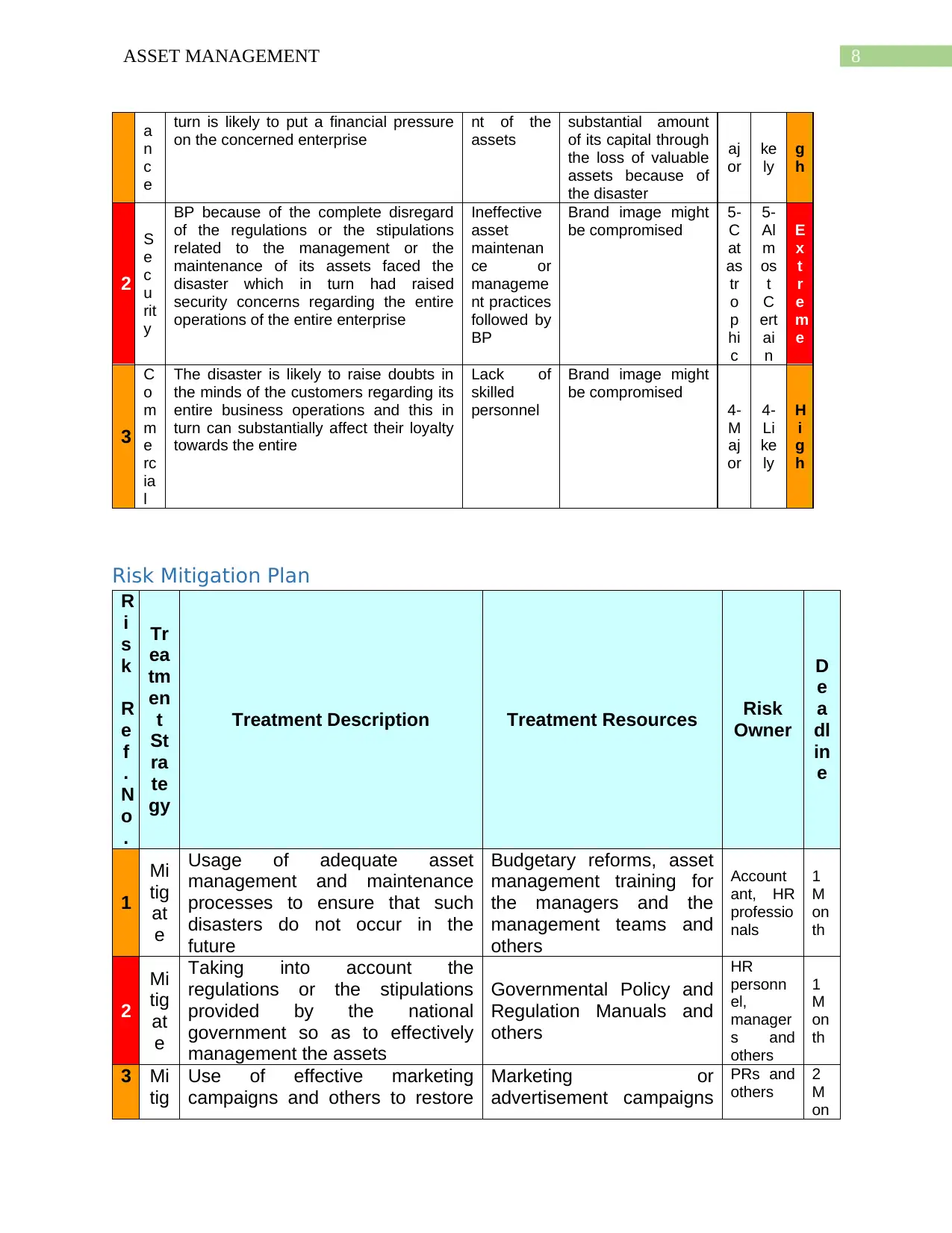
8ASSET MANAGEMENT
a
n
c
e
turn is likely to put a financial pressure
on the concerned enterprise
nt of the
assets
substantial amount
of its capital through
the loss of valuable
assets because of
the disaster
aj
or
ke
ly
g
h
2
S
e
c
u
rit
y
BP because of the complete disregard
of the regulations or the stipulations
related to the management or the
maintenance of its assets faced the
disaster which in turn had raised
security concerns regarding the entire
operations of the entire enterprise
Ineffective
asset
maintenan
ce or
manageme
nt practices
followed by
BP
Brand image might
be compromised
5-
C
at
as
tr
o
p
hi
c
5-
Al
m
os
t
C
ert
ai
n
E
x
t
r
e
m
e
3
C
o
m
m
e
rc
ia
l
The disaster is likely to raise doubts in
the minds of the customers regarding its
entire business operations and this in
turn can substantially affect their loyalty
towards the entire
Lack of
skilled
personnel
Brand image might
be compromised
4-
M
aj
or
4-
Li
ke
ly
H
i
g
h
Risk Mitigation Plan
R
i
s
k
R
e
f
.
N
o
.
Tr
ea
tm
en
t
St
ra
te
gy
Treatment Description Treatment Resources Risk
Owner
D
e
a
dl
in
e
1
Mi
tig
at
e
Usage of adequate asset
management and maintenance
processes to ensure that such
disasters do not occur in the
future
Budgetary reforms, asset
management training for
the managers and the
management teams and
others
Account
ant, HR
professio
nals
1
M
on
th
2
Mi
tig
at
e
Taking into account the
regulations or the stipulations
provided by the national
government so as to effectively
management the assets
Governmental Policy and
Regulation Manuals and
others
HR
personn
el,
manager
s and
others
1
M
on
th
3 Mi
tig
Use of effective marketing
campaigns and others to restore
Marketing or
advertisement campaigns
PRs and
others
2
M
on
a
n
c
e
turn is likely to put a financial pressure
on the concerned enterprise
nt of the
assets
substantial amount
of its capital through
the loss of valuable
assets because of
the disaster
aj
or
ke
ly
g
h
2
S
e
c
u
rit
y
BP because of the complete disregard
of the regulations or the stipulations
related to the management or the
maintenance of its assets faced the
disaster which in turn had raised
security concerns regarding the entire
operations of the entire enterprise
Ineffective
asset
maintenan
ce or
manageme
nt practices
followed by
BP
Brand image might
be compromised
5-
C
at
as
tr
o
p
hi
c
5-
Al
m
os
t
C
ert
ai
n
E
x
t
r
e
m
e
3
C
o
m
m
e
rc
ia
l
The disaster is likely to raise doubts in
the minds of the customers regarding its
entire business operations and this in
turn can substantially affect their loyalty
towards the entire
Lack of
skilled
personnel
Brand image might
be compromised
4-
M
aj
or
4-
Li
ke
ly
H
i
g
h
Risk Mitigation Plan
R
i
s
k
R
e
f
.
N
o
.
Tr
ea
tm
en
t
St
ra
te
gy
Treatment Description Treatment Resources Risk
Owner
D
e
a
dl
in
e
1
Mi
tig
at
e
Usage of adequate asset
management and maintenance
processes to ensure that such
disasters do not occur in the
future
Budgetary reforms, asset
management training for
the managers and the
management teams and
others
Account
ant, HR
professio
nals
1
M
on
th
2
Mi
tig
at
e
Taking into account the
regulations or the stipulations
provided by the national
government so as to effectively
management the assets
Governmental Policy and
Regulation Manuals and
others
HR
personn
el,
manager
s and
others
1
M
on
th
3 Mi
tig
Use of effective marketing
campaigns and others to restore
Marketing or
advertisement campaigns
PRs and
others
2
M
on
⊘ This is a preview!⊘
Do you want full access?
Subscribe today to unlock all pages.

Trusted by 1+ million students worldwide
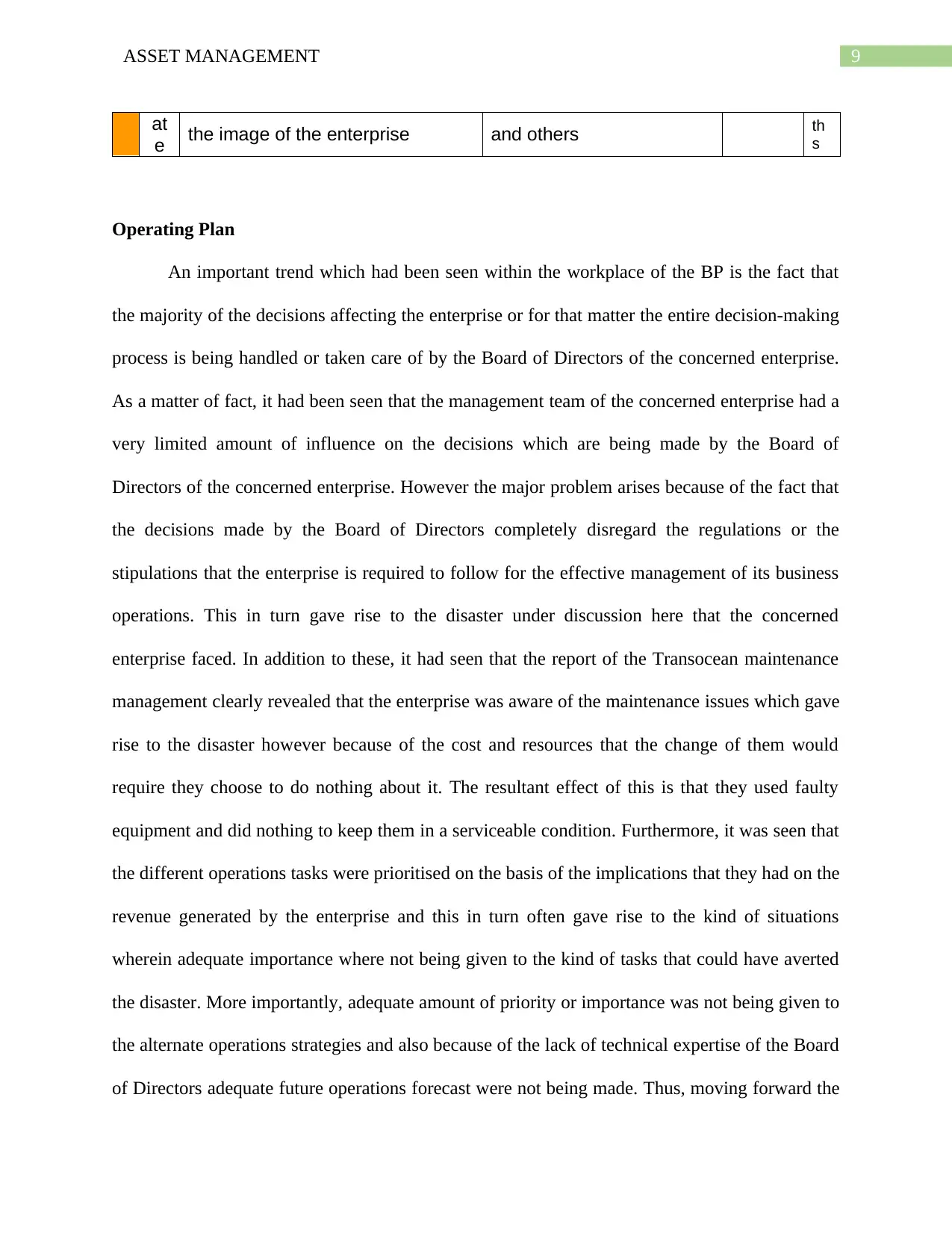
9ASSET MANAGEMENT
at
e the image of the enterprise and others th
s
Operating Plan
An important trend which had been seen within the workplace of the BP is the fact that
the majority of the decisions affecting the enterprise or for that matter the entire decision-making
process is being handled or taken care of by the Board of Directors of the concerned enterprise.
As a matter of fact, it had been seen that the management team of the concerned enterprise had a
very limited amount of influence on the decisions which are being made by the Board of
Directors of the concerned enterprise. However the major problem arises because of the fact that
the decisions made by the Board of Directors completely disregard the regulations or the
stipulations that the enterprise is required to follow for the effective management of its business
operations. This in turn gave rise to the disaster under discussion here that the concerned
enterprise faced. In addition to these, it had seen that the report of the Transocean maintenance
management clearly revealed that the enterprise was aware of the maintenance issues which gave
rise to the disaster however because of the cost and resources that the change of them would
require they choose to do nothing about it. The resultant effect of this is that they used faulty
equipment and did nothing to keep them in a serviceable condition. Furthermore, it was seen that
the different operations tasks were prioritised on the basis of the implications that they had on the
revenue generated by the enterprise and this in turn often gave rise to the kind of situations
wherein adequate importance where not being given to the kind of tasks that could have averted
the disaster. More importantly, adequate amount of priority or importance was not being given to
the alternate operations strategies and also because of the lack of technical expertise of the Board
of Directors adequate future operations forecast were not being made. Thus, moving forward the
at
e the image of the enterprise and others th
s
Operating Plan
An important trend which had been seen within the workplace of the BP is the fact that
the majority of the decisions affecting the enterprise or for that matter the entire decision-making
process is being handled or taken care of by the Board of Directors of the concerned enterprise.
As a matter of fact, it had been seen that the management team of the concerned enterprise had a
very limited amount of influence on the decisions which are being made by the Board of
Directors of the concerned enterprise. However the major problem arises because of the fact that
the decisions made by the Board of Directors completely disregard the regulations or the
stipulations that the enterprise is required to follow for the effective management of its business
operations. This in turn gave rise to the disaster under discussion here that the concerned
enterprise faced. In addition to these, it had seen that the report of the Transocean maintenance
management clearly revealed that the enterprise was aware of the maintenance issues which gave
rise to the disaster however because of the cost and resources that the change of them would
require they choose to do nothing about it. The resultant effect of this is that they used faulty
equipment and did nothing to keep them in a serviceable condition. Furthermore, it was seen that
the different operations tasks were prioritised on the basis of the implications that they had on the
revenue generated by the enterprise and this in turn often gave rise to the kind of situations
wherein adequate importance where not being given to the kind of tasks that could have averted
the disaster. More importantly, adequate amount of priority or importance was not being given to
the alternate operations strategies and also because of the lack of technical expertise of the Board
of Directors adequate future operations forecast were not being made. Thus, moving forward the
Paraphrase This Document
Need a fresh take? Get an instant paraphrase of this document with our AI Paraphraser
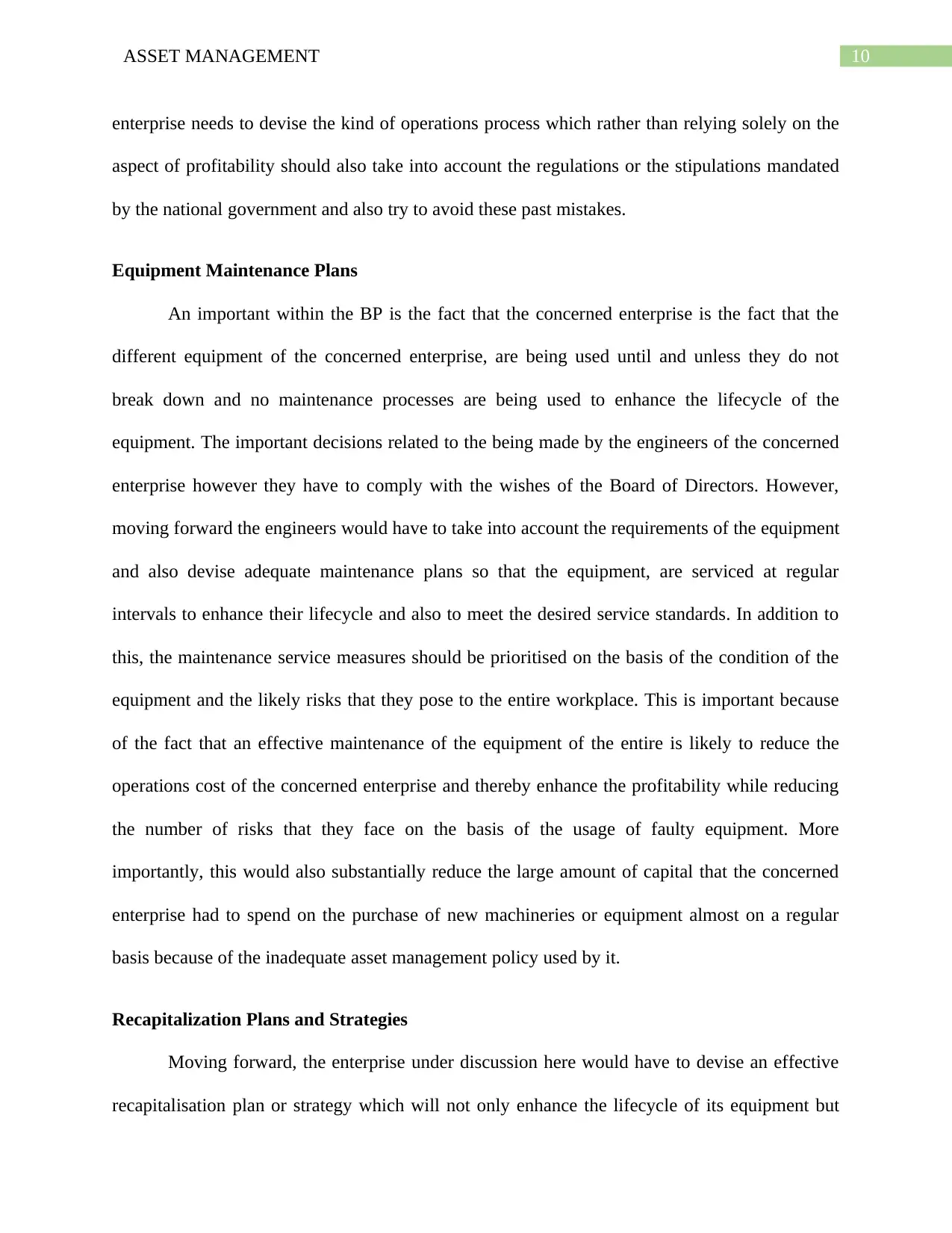
10ASSET MANAGEMENT
enterprise needs to devise the kind of operations process which rather than relying solely on the
aspect of profitability should also take into account the regulations or the stipulations mandated
by the national government and also try to avoid these past mistakes.
Equipment Maintenance Plans
An important within the BP is the fact that the concerned enterprise is the fact that the
different equipment of the concerned enterprise, are being used until and unless they do not
break down and no maintenance processes are being used to enhance the lifecycle of the
equipment. The important decisions related to the being made by the engineers of the concerned
enterprise however they have to comply with the wishes of the Board of Directors. However,
moving forward the engineers would have to take into account the requirements of the equipment
and also devise adequate maintenance plans so that the equipment, are serviced at regular
intervals to enhance their lifecycle and also to meet the desired service standards. In addition to
this, the maintenance service measures should be prioritised on the basis of the condition of the
equipment and the likely risks that they pose to the entire workplace. This is important because
of the fact that an effective maintenance of the equipment of the entire is likely to reduce the
operations cost of the concerned enterprise and thereby enhance the profitability while reducing
the number of risks that they face on the basis of the usage of faulty equipment. More
importantly, this would also substantially reduce the large amount of capital that the concerned
enterprise had to spend on the purchase of new machineries or equipment almost on a regular
basis because of the inadequate asset management policy used by it.
Recapitalization Plans and Strategies
Moving forward, the enterprise under discussion here would have to devise an effective
recapitalisation plan or strategy which will not only enhance the lifecycle of its equipment but
enterprise needs to devise the kind of operations process which rather than relying solely on the
aspect of profitability should also take into account the regulations or the stipulations mandated
by the national government and also try to avoid these past mistakes.
Equipment Maintenance Plans
An important within the BP is the fact that the concerned enterprise is the fact that the
different equipment of the concerned enterprise, are being used until and unless they do not
break down and no maintenance processes are being used to enhance the lifecycle of the
equipment. The important decisions related to the being made by the engineers of the concerned
enterprise however they have to comply with the wishes of the Board of Directors. However,
moving forward the engineers would have to take into account the requirements of the equipment
and also devise adequate maintenance plans so that the equipment, are serviced at regular
intervals to enhance their lifecycle and also to meet the desired service standards. In addition to
this, the maintenance service measures should be prioritised on the basis of the condition of the
equipment and the likely risks that they pose to the entire workplace. This is important because
of the fact that an effective maintenance of the equipment of the entire is likely to reduce the
operations cost of the concerned enterprise and thereby enhance the profitability while reducing
the number of risks that they face on the basis of the usage of faulty equipment. More
importantly, this would also substantially reduce the large amount of capital that the concerned
enterprise had to spend on the purchase of new machineries or equipment almost on a regular
basis because of the inadequate asset management policy used by it.
Recapitalization Plans and Strategies
Moving forward, the enterprise under discussion here would have to devise an effective
recapitalisation plan or strategy which will not only enhance the lifecycle of its equipment but
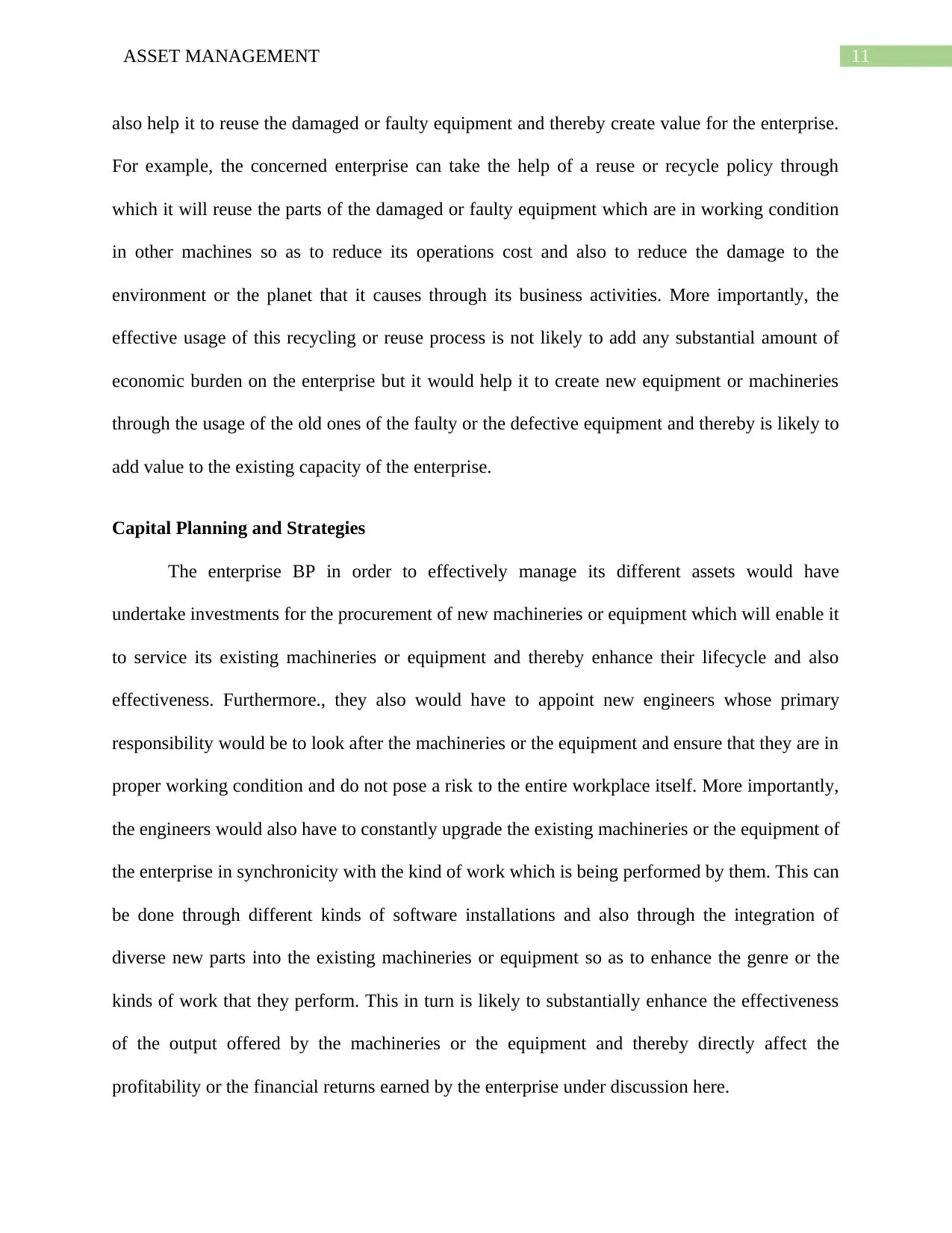
11ASSET MANAGEMENT
also help it to reuse the damaged or faulty equipment and thereby create value for the enterprise.
For example, the concerned enterprise can take the help of a reuse or recycle policy through
which it will reuse the parts of the damaged or faulty equipment which are in working condition
in other machines so as to reduce its operations cost and also to reduce the damage to the
environment or the planet that it causes through its business activities. More importantly, the
effective usage of this recycling or reuse process is not likely to add any substantial amount of
economic burden on the enterprise but it would help it to create new equipment or machineries
through the usage of the old ones of the faulty or the defective equipment and thereby is likely to
add value to the existing capacity of the enterprise.
Capital Planning and Strategies
The enterprise BP in order to effectively manage its different assets would have
undertake investments for the procurement of new machineries or equipment which will enable it
to service its existing machineries or equipment and thereby enhance their lifecycle and also
effectiveness. Furthermore., they also would have to appoint new engineers whose primary
responsibility would be to look after the machineries or the equipment and ensure that they are in
proper working condition and do not pose a risk to the entire workplace itself. More importantly,
the engineers would also have to constantly upgrade the existing machineries or the equipment of
the enterprise in synchronicity with the kind of work which is being performed by them. This can
be done through different kinds of software installations and also through the integration of
diverse new parts into the existing machineries or equipment so as to enhance the genre or the
kinds of work that they perform. This in turn is likely to substantially enhance the effectiveness
of the output offered by the machineries or the equipment and thereby directly affect the
profitability or the financial returns earned by the enterprise under discussion here.
also help it to reuse the damaged or faulty equipment and thereby create value for the enterprise.
For example, the concerned enterprise can take the help of a reuse or recycle policy through
which it will reuse the parts of the damaged or faulty equipment which are in working condition
in other machines so as to reduce its operations cost and also to reduce the damage to the
environment or the planet that it causes through its business activities. More importantly, the
effective usage of this recycling or reuse process is not likely to add any substantial amount of
economic burden on the enterprise but it would help it to create new equipment or machineries
through the usage of the old ones of the faulty or the defective equipment and thereby is likely to
add value to the existing capacity of the enterprise.
Capital Planning and Strategies
The enterprise BP in order to effectively manage its different assets would have
undertake investments for the procurement of new machineries or equipment which will enable it
to service its existing machineries or equipment and thereby enhance their lifecycle and also
effectiveness. Furthermore., they also would have to appoint new engineers whose primary
responsibility would be to look after the machineries or the equipment and ensure that they are in
proper working condition and do not pose a risk to the entire workplace itself. More importantly,
the engineers would also have to constantly upgrade the existing machineries or the equipment of
the enterprise in synchronicity with the kind of work which is being performed by them. This can
be done through different kinds of software installations and also through the integration of
diverse new parts into the existing machineries or equipment so as to enhance the genre or the
kinds of work that they perform. This in turn is likely to substantially enhance the effectiveness
of the output offered by the machineries or the equipment and thereby directly affect the
profitability or the financial returns earned by the enterprise under discussion here.
⊘ This is a preview!⊘
Do you want full access?
Subscribe today to unlock all pages.

Trusted by 1+ million students worldwide
1 out of 17
Related Documents
Your All-in-One AI-Powered Toolkit for Academic Success.
+13062052269
info@desklib.com
Available 24*7 on WhatsApp / Email
![[object Object]](/_next/static/media/star-bottom.7253800d.svg)
Unlock your academic potential
Copyright © 2020–2025 A2Z Services. All Rights Reserved. Developed and managed by ZUCOL.




